In this tutorial you follow the steps of the When-to-Worry-and-How-to-Avoid-the-Misuse-of-Bayesian-Statistics – checklist (the WAMBS-checklist).
We are continuously improving the tutorials so let me know if you discover mistakes, or if you have additional resources I can refer to. The source code is available via Github. If you want to be the first to be informed about updates, follow me on Twitter.
Preparation
This tutorial expects:
- Version 8 or higher of Mplus.This tutorial was made using Mplus version 8_3.
- Basic knowledge of hypothesis testing
- Basic knowledge of correlation and regression
- Basic knowledge of Bayesian inference
- Basic knowledge of coding in Mplus
WAMBS checklist
When to worry, and how to Avoid the Misuse of Bayesian Statistics
To be checked before estimating the model
- Do you understand the priors?
To be checked after estimation but before inspecting model results
- Does the trace-plot exhibit convergence?
- Does convergence remain after doubling the number of iterations?
- Does the posterior distribution histogram have enough information?
- Do the chains exhibit a strong degree of autocorrelation?
- Do the posterior distributions make substantive sense?
Understanding the exact influence of the priors
- Do different specification of the multivariate variance priors influence the results?
- Is there a notable effect of the prior when compared with non-informative priors?
- Are the results stable from a sensitivity analysis?
- Is the Bayesian way of interpreting and reporting model results used?
Example Data
The data we will be using for this exercise is based on a study about predicting PhD-delays (Van de Schoot, Yerkes, Mouw and Sonneveld 2013).The data can be downloaded here. Among many other questions, the researchers asked the Ph.D. recipients how long it took them to finish their Ph.D. thesis (n=333). It appeared that Ph.D. recipients took an average of 59.8 months (five years and four months) to complete their Ph.D. trajectory. The variable B3_difference_extra measures the difference between planned and actual project time in months (mean=9.97, minimum=-31, maximum=91, sd=14.43). For more information on the sample, instruments, methodology and research context we refer the interested reader to the paper.
For the current exercise we are interested in the question whether age (M = 31.7, SD = 6.86) of the Ph.D. recipients is related to a delay in their project.
The relation between completion time and age is expected to be non-linear. This might be due to that at a certain point in your life (i.e., mid thirties), family life takes up more of your time than when you are in your twenties or when you are older.
So, in our model the \(gap\) (B3_difference_extra) is the dependent variable and \(age\) (E22_Age) and \(age^2\)(E22_Age_Squared ) are the predictors. The data can be found in the file phd-delays_nonames.csv . (In Mplus the first row CANNOT have the variable names, these have already been deleted for you)
Question: Write down the null and alternative hypotheses that represent this question. Which hypothesis do you deem more likely?
\(H_0:\) \(age\) is not related to a delay in the PhD projects.
\(H_1:\) \(age\) is related to a delay in the PhD projects.
\(H_0:\) \(age^2\) is not related to a delay in the PhD projects.
\(H_1:\) \(age^2\) is related to a delay in the PhD projects.
Preparation – Importing and Exploring Data
You can find the data in the file phd-delays_nonames.csv , which contains all variables that you need for this analysis. Although it is a .csv-file, you can directly load it into Mplus using the following syntax:
TITLE: Bayesian analysis summary
DATA: FILE IS phd-delays_nonames.csv;
VARIABLE: NAMES ARE diff child sex Age Age2;
USEVARIABLES ARE diff Age Age2;
OUTPUT: sampstat;Once you loaded in your data, it is advisable to check whether your data import worked well. Therefore, first have a look at the summary statistics of your data. You can do this by looking at the sampstat ouput.
Question: Have all your data been loaded in correctly? That is, do all data points substantively make sense? If you are unsure, go back to the .csv-file to inspect the raw data.
MODEL RESULTS
Two-Tailed
Estimate S.E. Est./S.E. P-Value
Means
DIFF 9.967 0.790 12.622 0.000
AGE 31.676 0.375 84.433 0.000
AGE2 1050.217 35.916 29.241 0.000The descriptive statistics make sense:
\(diff\): Mean (9.97), SE (0.790)
\(Age\): Mean (31.68), SE (0.38)
\(Age^2\): Mean (1050.22), SE (35.92)
Step 1: Do you understand the priors?
1.Do you understand the priors?
Before actually looking at the data we first need to think about the prior distributions and hyperparameters for our model. For the current model, there are four priors:
- the intercept
- the two regression parameters (\(\beta_1\) for the relation with AGE and \(\beta_2\) for the relation with AGE2)
- the residual variance (\(\in\))
We first need to determine which distribution to use for the priors. Let’s use for the
- intercept a normal prior with \(\mathcal{N}(\mu_0, \sigma^{2}_{0})\), where \(\mu_0\) is the prior mean of the distribution and \(\sigma^{2}_{0}\) is the variance parameter
- \(\beta_1\) a normal prior with \(\mathcal{N}(\mu_1, \sigma^{2}_{1})\)
- \(\beta_2\) a normal prior with \(\mathcal{N}(\mu_2, \sigma^{2}_{2})\)
- \(\in\) an Inverse Gamma distribution with \(IG(\kappa_0,\theta_0)\), where \(\kappa_0\) is the shape parameter of the distribution and \(\theta_0\) the rate parameter
Next, we need to specify actual values for the hyperparameters of the prior distributions. Let’s say we found a previous study and based on this study the following hyperparameters can be specified:
- intercept \(\sim \mathcal{N}(-35, 20)\)
- \(\beta_1 \sim \mathcal{N}(.8, 5)\)
- \(\beta_2 \sim \mathcal{N}(0, 10)\)
- \(\in \sim IG(.5, .5)\) This is an uninformative prior for the residual variance, which has been found to perform well in simulation studies.
It is a good idea to plot these distribution to see how they loo and waht expected delay would be given these priors. With these priors the regression formula would be: \(delay=-35+ .8*age + 0*age^2\). In the Blavaan version of the WAMBS checklist we explain how you can easily do that in R.
To run a multiple regression with Mplus, you first specify the model (after the MODEL line using the ON command for regression coefficients, and the [] command for the intercept/means). As default Mplus does not run a Bayesian analysis, so you would have to change the ESTIMATOR to BAYES under ANALYSIS in the input file and then look at the output under MODEL RESULTS. In Mplus, the priors are set in the under the MODEL PRIORS command using the ~ sign, an N for a normal distribution, and an IG for the inverse gamma distribution. To see what default priors Mplus uses we can have a look at the Appendix A of this manual.
The priors are presented in code as follows:
TITLE: Bayesian analysis;
DATA: FILE IS phd-delays_nonames.csv;
VARIABLE: NAMES ARE diff child sex Age Age2; ! All the variables in the dataset
USEVARIABLES ARE diff Age Age2; ! The variables we use in this analysis
ANALYSIS:
ESTIMATOR IS bayes; ! Specify that we want to use a Bayesian analysis
Bseed = 23082018; !specify a seed value for reproducing the results
CHAINS = 3; ! set the number of chains we want to use
MODEL:
[diff] (intercept); ! specify that we want an intercept
! this model would also work without this line, but this way it is possible to easily set a prior
diff ON Age (Beta_Age); ! Regression coefficient 1.
diff ON Age2(Beta_Age2); ! Regression coefficient 2
! You need to name these regression coefficients to later set priors
diff (e); ! Error variance
MODEL PRIORS:
Beta_Age ~ N(.8, 5); ! These are the different priors
Beta_Age2 ~ N(0, 10);
intercept ~ N(-35, 20);
e ~ IG(0.5, 0.5);
OUTPUT:
cinterval(hpd); !to request CIs based on higher posterior density intervals
tech8; !to request additional information about priors and convergence
PLOT:
TYPE IS PLOT2; !to request for plotsTo check the prior distribution in Mplus you have to first run the analysis adding PLOT: TYPE IS PLOT2; to the input file. Then, in the top menu of Mplus, go to Plot > View Plots > Bayesian prior parameter distribution > view > select the parameter you would like to see the prior of > kernel density > OK Inspect all priors. (Be careful the actual density you see, is the density of the posterior, the prior is summarized in the different coloured lines. This seems to be a bit of a bug in Mplus)
As an example the prior distribution of the regression coefficient for age 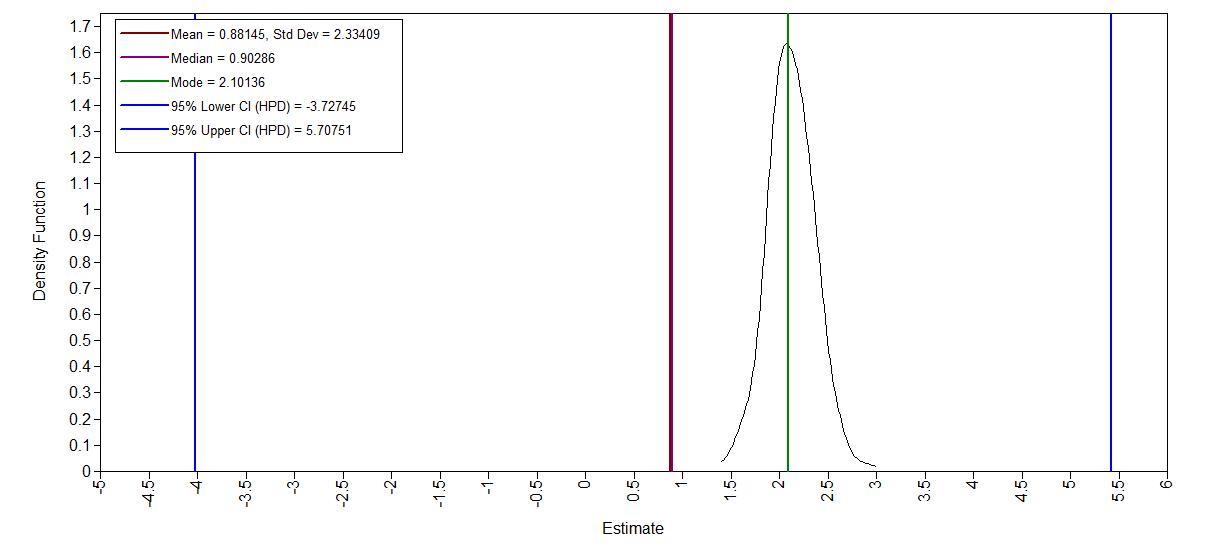
Step 2: Run the model and check for convergence
To run a multiple regression in Mplus with a specific number of iteratation, you first specify the model as before but add FBITERATIONS = xxx; to the ANALYSIS part of the input file.
2. Does the trace-plot exhibit convergence?
By default Mplus discards half of the iteration as burnin period. After running this model we can check the trace plots by going to Plot > View Plots > Bayesian posterior parameter trace plots > view > select the parameter you would like to see the prior of > OK
First, run the model with only 100 iterations. Inspect the traceplots, what do you conclude?
TITLE: Bayesian analysis;
DATA: FILE IS phd-delays_nonames.csv;
VARIABLE: NAMES ARE diff child sex Age Age2; ! All the variables in the dataset
USEVARIABLES ARE diff Age Age2; ! The variables we use in this analysis
ANALYSIS:
ESTIMATOR IS bayes; ! Specify that we want to use a Bayesian analysis
Bseed = 23082018; !specify a seed value for reproducing the results
CHAINS = 3; ! set the number of chains we want to use
FBITERATIONS = 100 ! this is how we set the number of iterators
MODEL:
[diff] (intercept); ! specify that we want an intercept
! this model would also work without this line, but this way it is possible to easily set a prior
diff ON Age (Beta_Age); ! Regression coefficient 1.
diff ON Age2(Beta_Age2); ! Regression coefficient 2
! You need to name these regression coefficients to later set priors
diff (e); ! Error variance
MODEL PRIORS:
Beta_Age ~ N(.8, 5); ! These are the different priors
Beta_Age2 ~ N(0, 10);
intercept ~ N(-35, 20);
e ~ IG(0.5, 0.5);
OUTPUT:
cinterval(hpd); !to request CIs based on higher posterior density intervals
tech8; !to request additional information about priors and convergence
PLOT:
TYPE IS PLOT2; !to request for plotstrace plot age 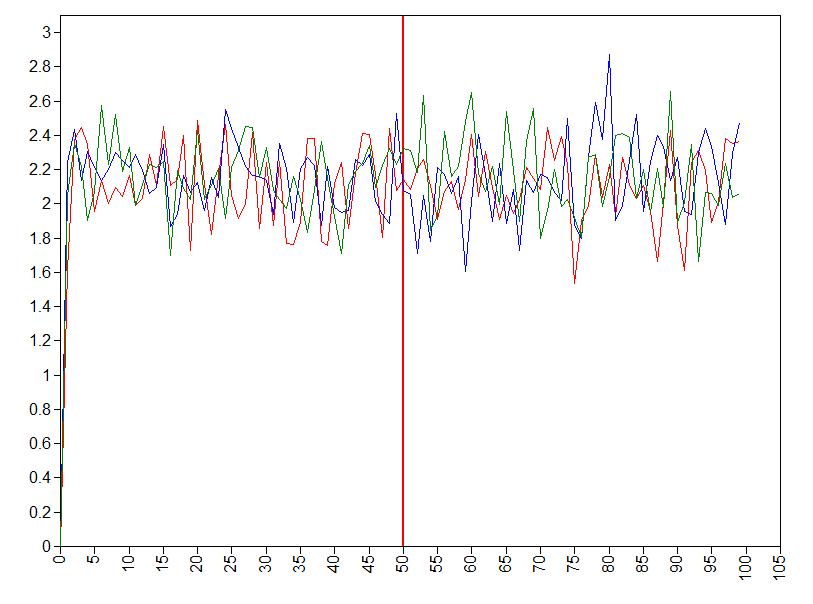
Clearly, two times 50 iterations is not enough for obtaining trusthworthy results and we need more iterations.
Let’s specify a fixed number of iterations by adding FBITERATIONS = 2000; to the ANALYSIS part. Inspect the traceplots again.
trace plot intercept 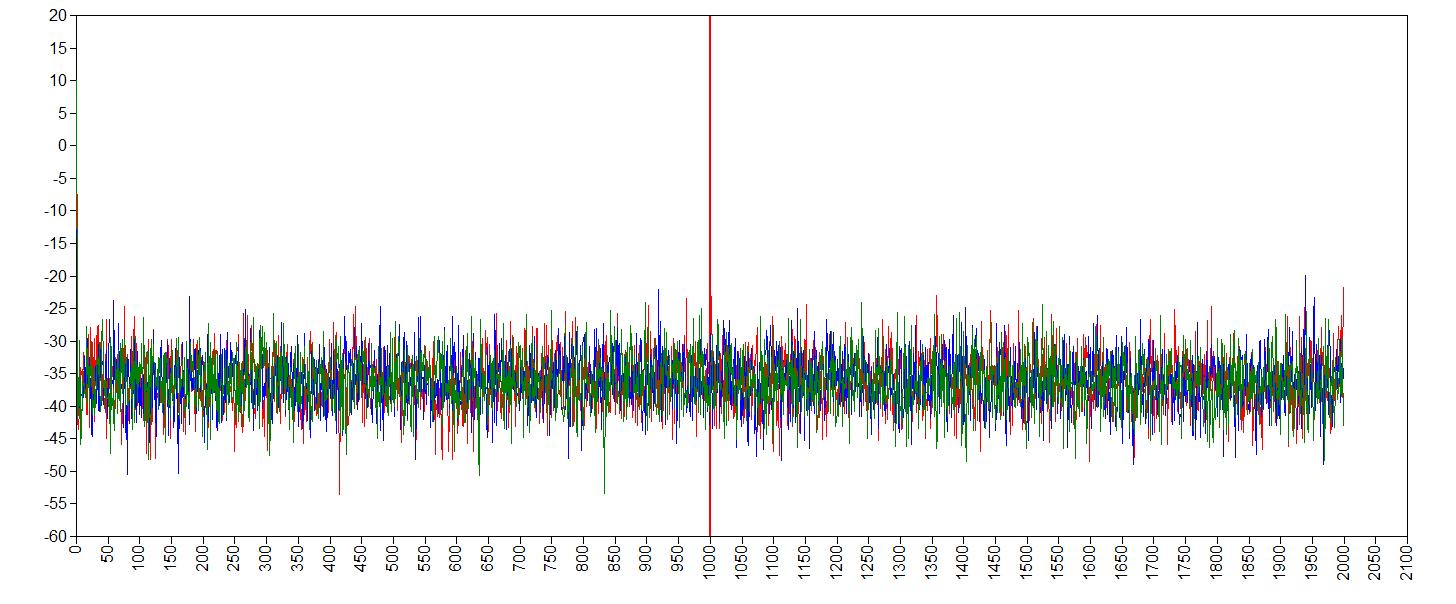
trace plot age 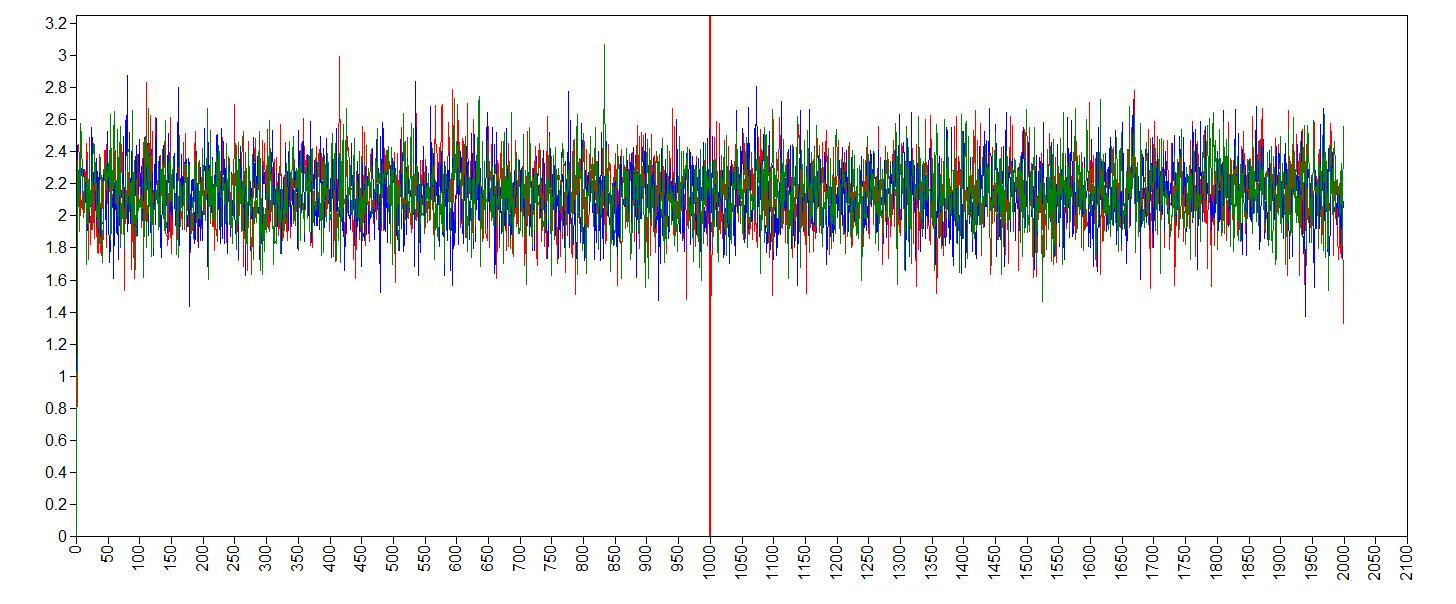
First we run the anlysis with a urnin period of 1000 samples and then take another 1000 samples.
trace plot age^2 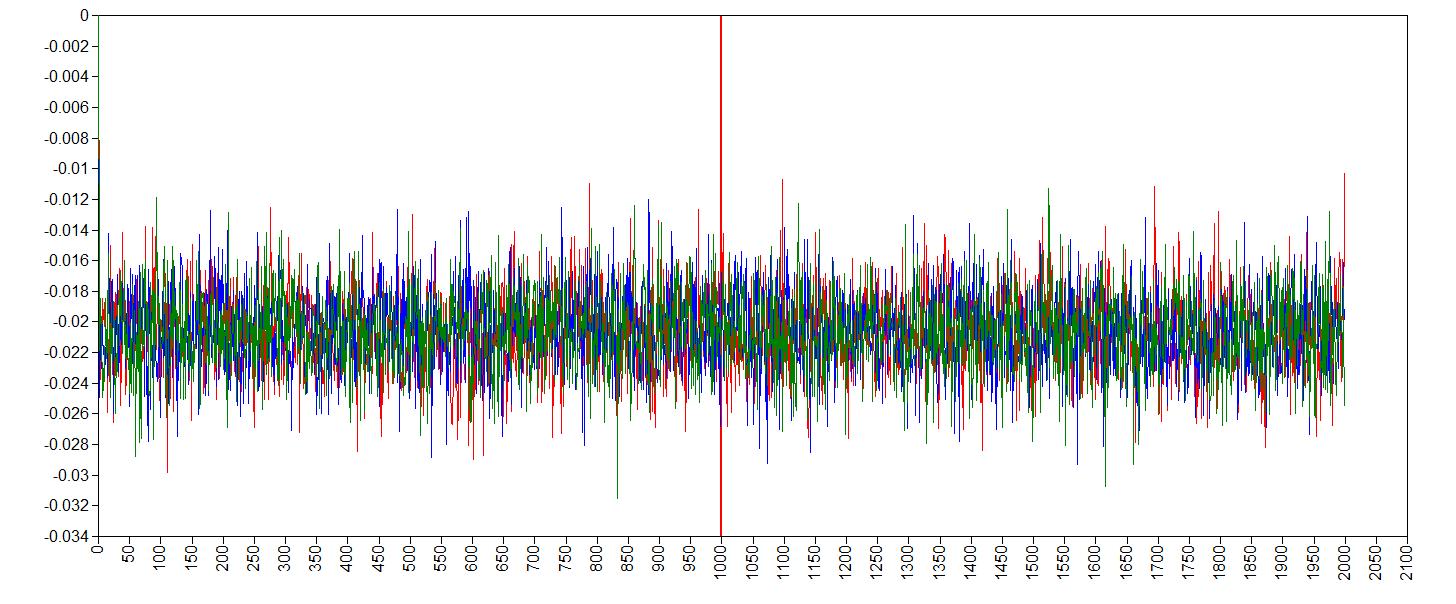
trace plot error variance 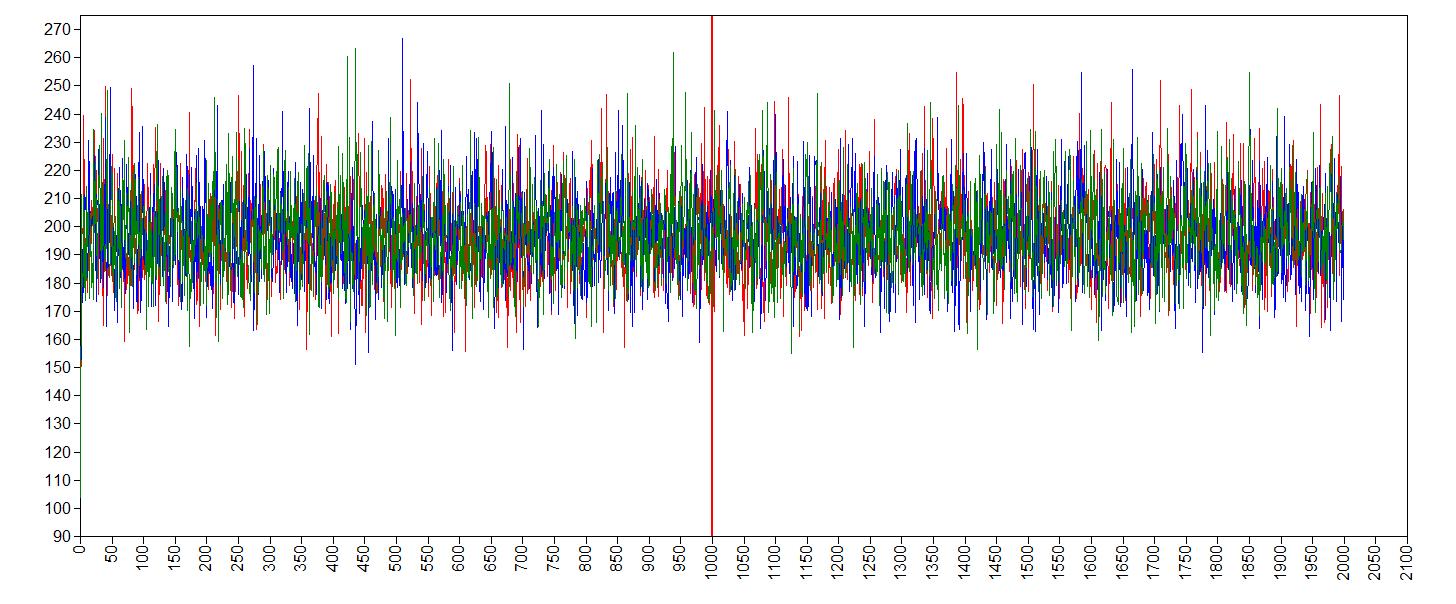
It seems like the trace (caterpillar) plots are neatly converged into one each other (we ideally want one fat caterpillar). This indicates we already have enough samples.
We can double check check if the chains converged by having a look at the convergence diagnostics, the Gelman and Rubin diagnostic. To have a look at the Gelman-Rubin Diagnostic (PSRF) we can check this table under the TECH8outout of Mplus. The Gelman-Rubin Diagnostic shows the PSRF values (using the within and between chain variability), which should be close to 1 for ALL iterations after burn-in. Is this the case?.
TECHNICAL 8 OUTPUT FOR BAYES ESTIMATION
CHAIN BSEED
1 23082018
2 147894
3 830180
POTENTIAL PARAMETER WITH
ITERATION SCALE REDUCTION HIGHEST PSR
100 1.000 1
200 1.000 1
300 1.000 1
400 1.000 1
500 1.001 2
600 1.002 2
700 1.002 2
800 1.002 2
900 1.002 2
1000 1.001 2
1100 1.000 2
1200 1.001 1
1300 1.001 1
1400 1.001 1
1500 1.001 1
1600 1.000 2
1700 1.000 1
1800 1.000 1
1900 1.000 1
2000 1.000 1The PSRF for all iterations after burn-in is close to 1, so convergence seems to have been reached.
3. Does convergence remain after doubling the number of iterations?
As is recommended in the WAMBS checklist, we double the amount of iterations to check for local convergence. To this by changing this part of the input.
FBITERATIONS = 4000 ! this is how we set the number of iteratorsYou should again have a look at the above-mentioned convergence statistics, but we can also compute the relative bias to inspect if doubling the number of iterations influences the posterior parameter estimates (\(bias= 100*\frac{(model \; with \; double \; iteration \; – \; initial \; converged \; model )}{initial \; converged \; model}\)). In order to preserve clarity we just calculate the bias of the two regression coefficients.
You should combine the relative bias in combination with substantive knowledge about the metric of the parameter of interest to determine when levels of relative deviation are negligible or problematic. For example, with a regression coefficient of 0.001, a 5% relative deviation level might not be substantively relevant. However, with an intercept parameter of 50, a 10% relative deviation level might be quite meaningful. The specific level of relative deviation should be interpreted in the substantive context of the model. Some examples of interpretations are:
- if relative deviation is < |5|%, then do not worry;
- if relative deviation > |5|%, then rerun with 4x nr of iterations.
Question: calculate the relative bias. Are you satisfied with number of iterations, or do you want to re-run the model with even more iterations?
To get the relative bias simply save the means of the regression coefficients and other parameters for the two different analyses and compute the bias.
Model results for FBITERATIONS = 2000
MODEL RESULTS
Estimate
DIFF ON
AGE 2.143
AGE2 -0.021
Intercepts
DIFF -36.290
Residual Variances
DIFF 196.606 Part of Model results for FBITERATIONS = 4000
MODEL RESULTS
Estimate
DIFF ON
AGE 2.141
AGE2 -0.021
Intercepts
DIFF -36.194
Residual Variances
DIFF 196.343- \(100\cdot \frac{2.141- 2.143}{2.143} = 0.1\%\)
- \(100\cdot \frac{-0.021–0.021}{-0.021} = 0\%\)
- \(100\cdot \frac{36.194-36.290 }{-36.290} = 0.26\%\)
- \(100\cdot \frac{196.343-196.606}{196.606} = 0.13%\)
The relative bias is small enough (<5%), do no worry about it.
4. Does the posterior distribution histogram have enough information?
By having a look at the histogram we can check if they contain enough information. To plot the histograms go to Plot > View Plots > Bayesian posterior parameter distributions > view > curve type: histogram > select the parameter you would like to see the histogram of > OK. Also, compare these plots with the ones obatained from your first model.
Question: What can you conclude about distribution histograms?
histogram age 
histogram age^2 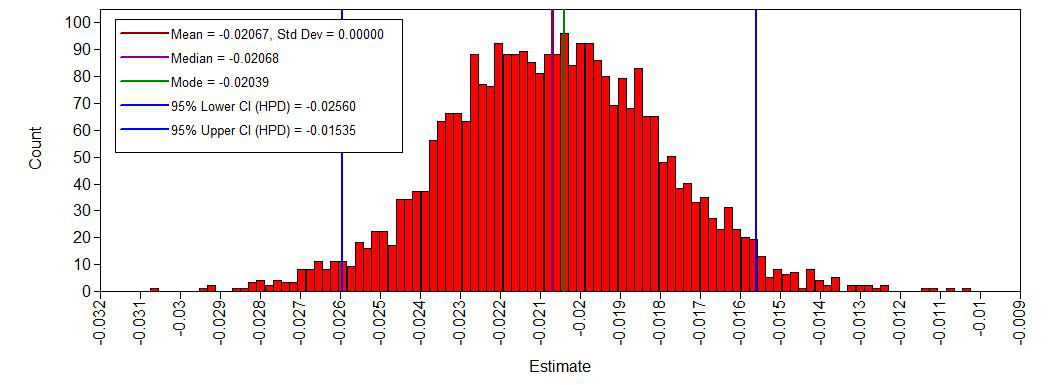
histogram intercept 
histogram error variance 
The histograms look smooth and have no gaps or other abnormalities. Based on this, adding more iterations is not necessary. However, if you arenot satisfied, you can improve the number of iterations again. Posterior distributions do not have to be symmetrical, but in this example they seem to be.If we compare this with histograms based on the first analysis (with very few iterations), this difference becomes clear:
histogram age 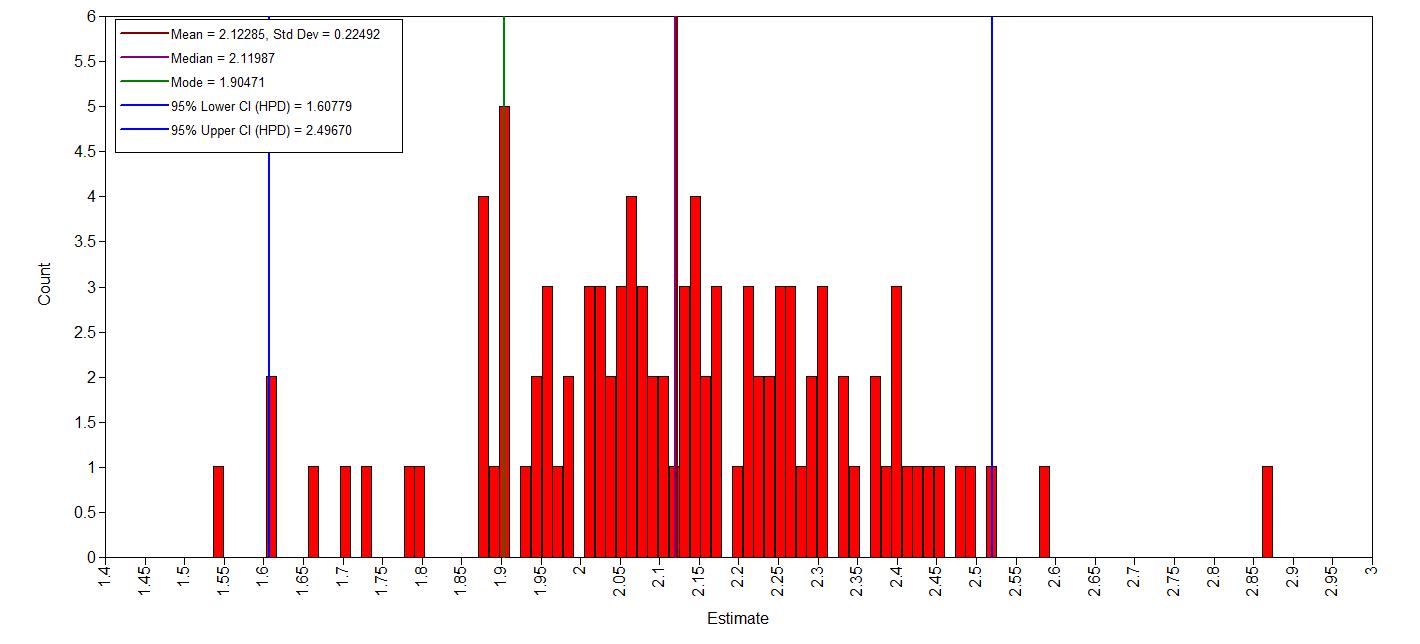
5. Do the chains exhibit a strong degree of autocorrelation?
To obtain information about autocorrelations you can use (Plot > View Plots > Bayesian autocorrelation plots > view > select the parameter you would like to see the autocorrelation of > OK)
Question: What can you conclude about these autocorrelation plots?
As an example the autocorrelation for the age regression coefficient:
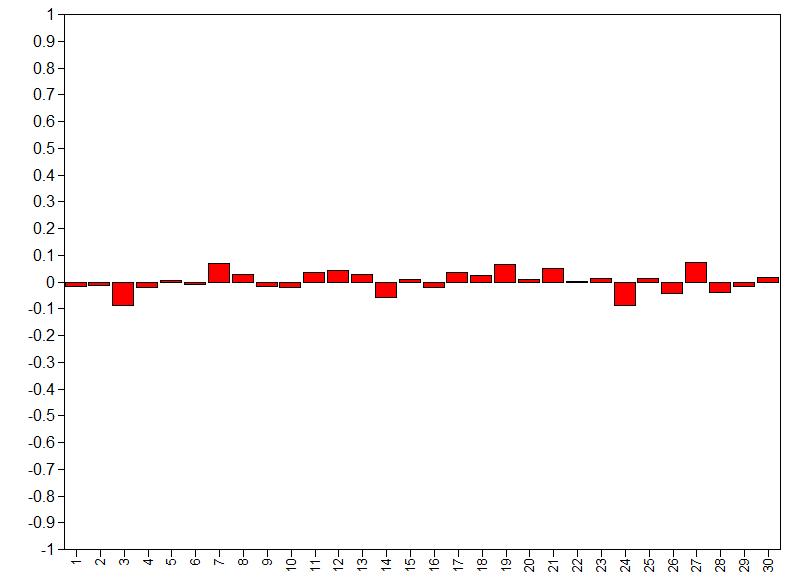
Autocorrelation is relatively small over lags (largest absolute values is below .20), so we don’t need more iterations. For more informtation on autocorrelation check this paper.
6. Do the posterior distributions make substantive sense?
We plot the posterior distributions and see if they are unimodel (one peak), if they are clearly centered around one value, if they give a realistic estimate and if they make substantive sense compared to our prior beliefs (priors). Here we plot the posteriors of the regression coefficients. To plot the densities go to Plot > View Plots > Bayesian posterior parameter distributions > view > curve type: Kernel densirty > select the parameter you would like to see the density of > OK
Question: What is your conclusion; do the posterior distributions make sense?
The posterior density plots:
Density posterior age 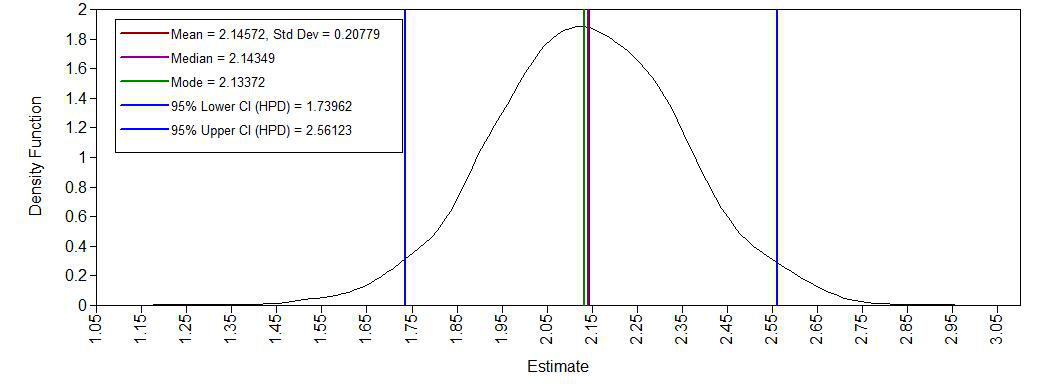
Density posterior age2 
Density posterior intercept 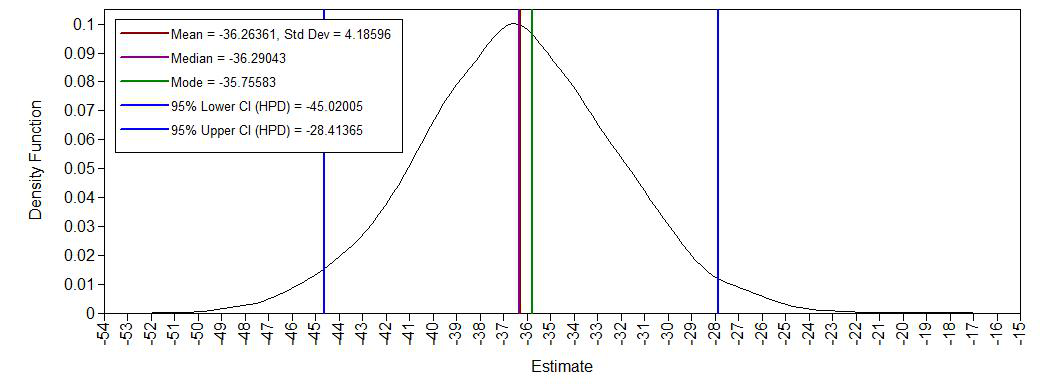
Density posterior error variance 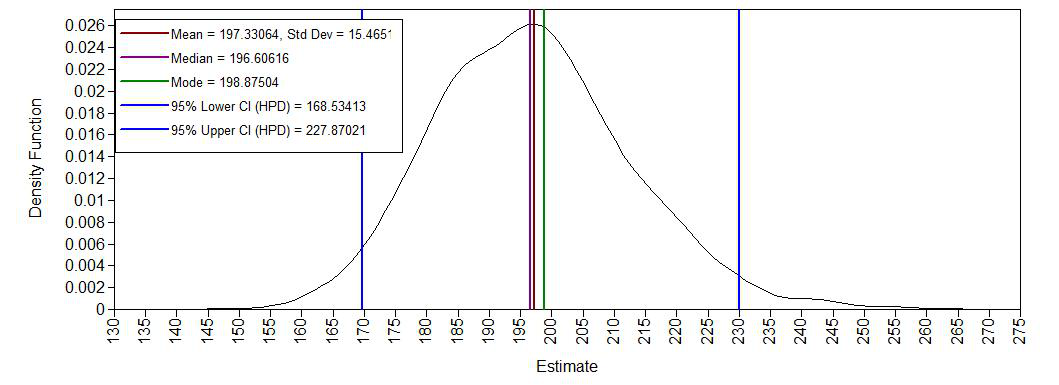
Yes, we see a clear negative intercept, which makes sense since a value of age = 0 for Ph.D is impossible. We also have have plausible ranges of values for the regression coefficients and a positive variance.
step 3: Understanding the exact influence of the priors
First we check the results of the analysis with the priors we used so far.
MODEL RESULTS
Posterior One-Tailed 95% C.I.
Estimate S.D. P-Value Lower 2.5% Upper 2.5% Significance
DIFF ON
AGE 2.143 0.208 0.000 1.740 2.561 *
AGE2 -0.021 0.003 0.000 -0.026 -0.015 *
Intercepts
DIFF -36.290 4.187 0.000 -45.020 -28.414 *
Residual Variances
DIFF 196.606 15.468 0.000 168.534 227.870 *7. Do different specification of the variance priors influence the results?
To understand how the prior on the residual variance impacts the posterior results, we compare the previous model with a model where different hyperparameters for the Inverse Gamma distribution are specified. To see what default priors Mplus uses we can have a look at the Appendix A of this manual: “The default for variance parameters, i.e., variance covariance blocks of size 1 is \(IG(-1,0)\)”. in theTECH8output this is summarized as:
PRIORS FOR ALL PARAMETERS PRIOR MEAN PRIOR VARIANCE PRIOR STD. DEV.
Parameter 4~IG(-1.000,0.000) infinity infinity infinitySo far we have used the –\(\in \sim IG(.5, .5)\) prior, but we can also use the –\(\in \sim IG(.01, .01)\) prior and see if doing so makes a difference. To quantify this difference we again calculate a relative bias. We change the hyperparameters in the regression model that was specified in step 2 using the ~ command. After rerunning the analysis we can then calculate a bias to see the influence of different priors
Question: Are the results robust for different specifications of the prior on the residual variance (compute the relative bias)?
| Parameters | Estimate with \(\in \sim IG(.01, .01)\) | Estimate with \(\in \sim IG(.5, .5)\) | Bias |
|---|---|---|---|
| Intercept | |||
| Age | |||
| Age2 | |||
| Residual variance |
Change this syntax
MODEL PRIORS:
Beta_Age ~ N(.8, 5);
Beta_Age2 ~ N(0, 10);
intercept ~ N(-35, 20);
e ~ IG(.01, .01);Part of Model results for e ~ IG(.01, .01)
MODEL RESULTS
Estimate
DIFF ON
AGE 2.143
AGE2 -0.021
Intercepts
DIFF -36.287
Residual Variances
DIFF 197.186 MODEL RESULTS
Posterior One-Tailed 95% C.I.
Estimate S.D. P-Value Lower 2.5% Upper 2.5% Significance
DIFF ON
AGE 2.143 0.208 0.000 1.740 2.561 *
AGE2 -0.021 0.003 0.000 -0.026 -0.015 *
Intercepts
DIFF -36.290 4.187 0.000 -45.020 -28.414 *
Residual Variances
DIFF 196.606 15.468 0.000 168.534 227.870 *| Parameters | Estimate with \(\in \sim IG(.01, .01)\) | Estimate with \(\in \sim IG(.5, .5)\) | Bias |
|---|---|---|---|
| Intercept | -36.287 | -36.290 | \(100\cdot \frac{-36.287 –36.290 }{-36.290 } = -0.01%\) |
| Age | 2.143 | 2.143 | 0 |
| Age2 | -0.021 | -0.021 | 0 |
| Residual variance | 197.186 | 196.606 | \(100\cdot \frac{ 197.186 -196.606}{196.606} = 0.295\%\) |
Yes, the results are robust, because there is only a really small amount of relative bias for the residual variance.
8. Is there a notable effect of the prior when compared with non-informative priors?
To see what default priors Mplus uses we can have a look at the Appendix A of this manual. “The default prior for intercepts, regression slopes, and loading parameters is \(\beta \sim \mathcal{N}(0, \infty)\).” This means in practice that we have a normal prior with a super wide variance, and allow probability mass across the entire parameter space. The default priors can also be found in the TECH8 output of Mplus
PRIORS FOR ALL PARAMETERS PRIOR MEAN PRIOR VARIANCE PRIOR STD. DEV.
Parameter 1~N(0.000,infinity) 0.0000 infinity infinity
Parameter 2~N(0.000,infinity) 0.0000 infinity infinity
Parameter 3~N(0.000,infinity) 0.0000 infinity infinity
Parameter 4~IG(-1.000,0.000) infinity infinity infinityQuestion: What is your conclusion about the influence of the priors on the posterior results?
To anwser this, rerun the model without the prior specifications in the input file and compute the relative bias.
| Parameters | Estimates with default priors | Estimate with informative priors | Bias |
|---|---|---|---|
| Intercept | |||
| Age | |||
| Age2 | |||
| Residual variance |
The estimates can once again be found in the MODEL RESULTS table
MODEL RESULTS
Estimate
DIFF ON
AGE 2.672
AGE2 -0.026
Intercepts
DIFF -47.409
Residual Variances
DIFF 198.461 | Parameters | Estimates with default priors | Estimate with informative priors | Bias |
|---|---|---|---|
| Intercept | -47.41 | -36.29 | \(100\cdot \frac{ -47.41 –36.29} { -36.29} = 30.64\%\) |
| Age | 2.67 | 2.14 | \(100\cdot \frac{ 2.67-2.14}{ 2.14} = 24.77\%\) |
| Age2 | -0.026 | -0.021 | \(100\cdot \frac{ -0.026 –0.021 }{ -0.021 } = 23.81\%\) |
| Residual variance | 198.46 | 197.19 | \(100\cdot \frac{ 198.46-197.19}{ 197.19} = 0.64\%\) |
The informative priors have quite some influence (up to 30%) on the posterior results of the regression coefficients. This is not a bad thing, just important to keep in mind.
9. Are the results stable from a sensitivity analysis?
If you still have time left, you can adjust the hyperparameters of the priors upward and downward and re-estimating the model with these varied priors to check for robustness.
From the original paper:
“If informative or weakly-informative priors are used, then we suggest running a sensitivity analysis of these priors. When subjective priors are in place, then there might be a discrepancy between results using different subjective prior settings. A sensitivity analysis for priors would entail adjusting the entire prior distribution (i.e., using a completely different prior distribution than before) or adjusting hyperparameters upward and downward and re-estimating the model with these varied priors. Several different hyperparameter specifications can be made in a sensitivity analysis, and results obtained will point toward the impact of small fluctuations in hyperparameter values. […] The purpose of this sensitivity analysis is to assess how much of an impact the location of the mean hyperparameter for the prior has on the posterior. […] Upon receiving results from the sensitivity analysis, assess the impact that fluctuations in the hyperparameter values have on the substantive conclusions. Results may be stable across the sensitivity analysis, or they may be highly unstable based on substantive conclusions. Whatever the finding, this information is important to report in the results and discussion sections of a paper. We should also reiterate here that original priors should not be modified, despite the results obtained.”
For more information on this topic, please also refer to this paper.
10. Is the Bayesian way of interpreting and reporting model results used?
For a summary on how to interpret and report models, please refer to https://www.rensvandeschoot.com/bayesian-analyses-where-to-start-and-what-to-report/
MODEL RESULTS
Posterior One-Tailed 95% C.I.
Estimate S.D. P-Value Lower 2.5% Upper 2.5% Significance
DIFF ON
AGE 2.143 0.208 0.000 1.740 2.561 *
AGE2 -0.021 0.003 0.000 -0.026 -0.015 *
Intercepts
DIFF -36.290 4.187 0.000 -45.020 -28.414 *
Residual Variances
DIFF 196.606 15.468 0.000 168.534 227.870 *In the current model we see that:
- The estimate for the intercept is -36.29 [-45.02; -28.41]
- The estimate for the effect of \(age\) is 2.14 [1.74 ; 2.56]
- The estimate for the effect of \(age^2\) is -0.021 [-0.026; -0.015]
We can see that none of 95% Posterior HPD Intervals for these effects include zero, which means we are can be quite certain that all of the effects are different from 0. Futhermore, yhe third column of the MODEL RESULTS table gives the one-tailed p-value based on the posterior distribution. For a positive estimate, the p-value is the proportion of the posterior distribution that is below zero. For a negative estimate, the p-value is the proportion of the posterior distribution that is above zero. So the a p- value of 0.000 means a probability is around >.999 that the corresponding parameter is not 0.
References
Depaoli, S., & Van de Schoot, R. (2017). Improving transparency and replication in Bayesian statistics: The WAMBS-Checklist. Psychological Methods, 22(2), 240.
Link, W. A., & Eaton, M. J. (2012). On thinning of chains in MCMC. Methods in ecology and evolution, 3(1), 112-115.
van Erp, S., Mulder, J., & Oberski, D. L. (2017). Prior sensitivity analysis in default Bayesian structural equation modeling.
Van de Schoot, R., & Depaoli, S. (2014). Bayesian analyses: Where to start and what to report. European Health Psychologist, 16(2), 75-84.

